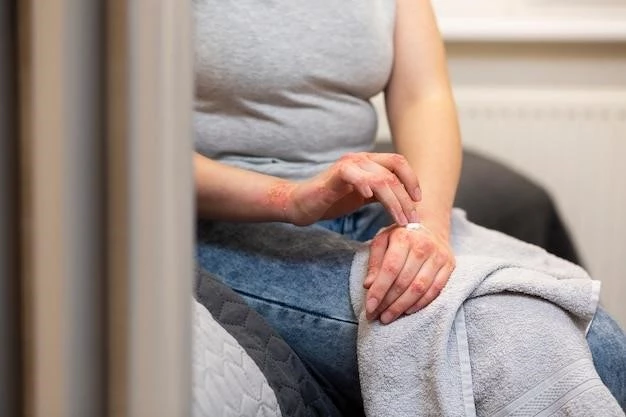Disease ー Lichen Sclerosus et Atrophicus
Lichen sclerosus et atrophicus, also known as LS, is a chronic skin condition that primarily affects the genital and anal areas. It is characterized by itching, inflammation, and thinning of the skin. LS is believed to be an autoimmune disease.
Diagnosis of LS involves a physical examination, a review of symptoms, and often a biopsy of the affected skin. Treatment options include topical steroids, protectants, and in severe cases, biologic therapy. It is crucial to monitor symptoms and complications closely to manage the condition effectively.
Overview of Lichen Sclerosus et Atrophicus
Lichen sclerosus et atrophicus (LS) is a chronic inflammatory skin condition that primarily affects the genital and anal areas, although it can also occur on other parts of the body. It is more common in women than in men, with postmenopausal women being the most affected group.
LS presents as white, patchy areas of thin skin that may appear wrinkled and be accompanied by itching, discomfort, and pain. The exact cause of LS is unknown, but it is believed to be an autoimmune condition, meaning the body’s immune system attacks healthy skin cells.
Individuals with LS may also experience scarring, fusion of the labia (in women), and phimosis (in men) due to the skin tightening and thickening. The condition can have a significant impact on a person’s quality of life, causing physical discomfort and emotional distress.
It is essential for those affected by LS to seek medical attention for an accurate diagnosis and appropriate treatment. Left untreated, LS can lead to complications such as tearing of the skin, urinary retention, painful intercourse, and an increased risk of skin cancer in the affected area.
Although LS is a chronic condition, with proper management and care, individuals can effectively control symptoms and prevent complications. Treatment typically involves topical steroids to reduce inflammation, moisturizers to hydrate the skin, and in severe cases, biologic therapy to target the immune response.
Monitoring symptoms, seeking regular medical follow-ups, and practicing good genital hygiene are crucial aspects of managing LS. By working closely with healthcare providers, individuals with LS can improve their quality of life and minimize the impact of this challenging skin condition.
Understanding the Condition
Lichen sclerosus et atrophicus (LS) is a chronic inflammatory skin condition that primarily affects the genital and anal areas. It is characterized by the appearance of white, patchy areas of thin and wrinkled skin. The exact cause of LS is not fully understood, but it is believed to be an autoimmune disorder.
LS is more common in women, especially postmenopausal women, although men and children can also be affected. The condition can cause itching, discomfort, and pain in the affected areas, leading to physical and emotional distress for individuals living with LS.
Over time, LS can result in scarring, fusion of the labia in women, and phimosis in men. These changes in the skin’s structure can lead to complications such as urinary retention, painful intercourse, and an increased risk of skin cancer in the affected areas.
Individuals with LS may also experience psychological challenges due to the visibility of the symptoms and the impact on their daily lives. Seeking a timely diagnosis and appropriate treatment is essential in managing LS effectively and preventing complications.
Healthcare providers may use a combination of physical examinations, review of symptoms, and skin biopsies to diagnose LS. Treatment options typically include topical steroids to reduce inflammation, moisturizers to hydrate the skin, and protectants to prevent irritation and injury.
In severe cases or when other treatments are ineffective, healthcare providers may recommend biologic therapy to target the underlying autoimmune response. Regular monitoring of symptoms and follow-up appointments are key components of managing LS and adjusting treatment as needed.
By understanding the nature of LS, its symptoms, and potential complications, individuals can work with their healthcare team to develop a personalized treatment plan that addresses their unique needs and improves their quality of life.
Diagnosis of Lichen Sclerosus et Atrophicus
Diagnosing lichen sclerosus et atrophicus (LS) typically involves a combination of physical examination, review of symptoms, and sometimes a skin biopsy. Healthcare providers will assess the affected areas, looking for characteristic white, thin, and wrinkled patches of skin.
During the physical examination, healthcare providers may also inquire about symptoms such as itching, discomfort, pain, and changes in urinary or sexual function. It is important for individuals to provide detailed information about their symptoms and medical history to assist in the diagnosis.
A skin biopsy, where a small sample of skin is taken and examined under a microscope, may be conducted to confirm the presence of LS. This procedure helps differentiate LS from other skin conditions that may have similar symptoms, ensuring an accurate diagnosis.
In some cases, healthcare providers may recommend additional tests to rule out other potential causes of the symptoms or to assess the extent of the condition. These tests may include blood tests, imaging studies, or further evaluation of the affected skin areas.
Receiving a prompt and accurate diagnosis is essential in starting appropriate treatment for LS. By working closely with healthcare providers and following their recommendations for diagnostic tests, individuals can ensure they receive the care needed to effectively manage LS and improve their quality of life.
Treatment Options
The treatment of lichen sclerosus et atrophicus (LS) focuses on managing symptoms, reducing inflammation, and preventing complications. Depending on the severity of the condition, healthcare providers may recommend various treatment options tailored to individual needs.
One of the most common treatments for LS is the use of topical corticosteroids. These medications help reduce inflammation and itching in the affected skin areas. Healthcare providers may prescribe different strengths of corticosteroids based on the severity of symptoms.
In addition to corticosteroids, moisturizers and emollients can be used to hydrate the skin and improve its elasticity. Keeping the affected areas well-moisturized can help prevent dryness and further irritation, contributing to overall skin health.
For individuals with LS who experience pain or discomfort, topical anesthetics or pain-relieving creams may be recommended to alleviate symptoms. These products can provide temporary relief and improve the quality of life for those living with LS.
In cases where standard treatments are ineffective or if LS is severe, healthcare providers may consider biologic therapy. Biologics work by targeting specific components of the immune system involved in the autoimmune response that drives LS, helping to control the condition.
It is essential for individuals with LS to follow their healthcare provider’s recommendations regarding treatment, including the application of medications as instructed and attending regular follow-up appointments. Monitoring symptoms and discussing any changes with a healthcare team is key to adjusting treatment as needed.
While there is no cure for LS, with proper treatment and management, individuals can effectively control symptoms, reduce inflammation, and prevent complications associated with the condition. By working collaboratively with healthcare providers, individuals can improve their quality of life and minimize the impact of LS on daily activities.
Monitoring and Managing Symptoms
Monitoring and managing symptoms of lichen sclerosus et atrophicus (LS) are crucial aspects of ensuring effective treatment and minimizing complications. Individuals living with LS should actively monitor changes in their skin, itching, discomfort, and other symptoms.
Regular self-examinations of the affected areas can help individuals track the progression of LS and detect any new or worsening symptoms. Any changes in the appearance of the skin, such as increased redness, thickening, or ulcers, should be promptly reported to healthcare providers.
In addition to self-monitoring, attending scheduled follow-up appointments with healthcare providers is essential for assessing the response to treatment and making any necessary adjustments; Healthcare providers may conduct physical examinations and recommend further testing to evaluate the effectiveness of the treatment plan.
Managing symptoms of LS involves following the prescribed treatment regimen, including the use of topical medications, moisturizers, and other therapies as recommended. Consistent application of medications and practicing good genital hygiene can help alleviate symptoms and improve skin health.
Individuals with LS should also be mindful of lifestyle factors that can impact the condition, such as wearing loose-fitting clothing, avoiding irritants, and maintaining a healthy weight. Making lifestyle modifications that promote skin health can contribute to managing LS effectively.
Communication with healthcare providers about symptom management is essential. If individuals experience persistent or severe symptoms, they should seek medical attention promptly. Adjustments to the treatment plan may be necessary to address new or worsening symptoms and prevent complications.
By actively monitoring symptoms, following the prescribed treatment plan, and collaborating with healthcare providers, individuals can effectively manage LS and improve their quality of life. Open communication and proactive management of symptoms play a vital role in controlling the condition and promoting overall well-being.
Potential Complications of Lichen Sclerosus et Atrophicus
Lichen sclerosus et atrophicus (LS) can lead to various complications if left untreated or poorly managed. These complications can range from physical discomfort to more serious health concerns that impact a person’s quality of life and overall well-being.

One common complication of LS is the development of fissures or tears in the affected skin areas. These fissures can cause pain, discomfort, and potential bleeding, leading to further irritation and inflammation. Proper management of LS can help prevent these fissures from occurring.
In severe cases, LS can result in scarring and skin changes that affect the normal functionality of the genital or anal areas. Scarring may lead to fusion of the labia in women, making urination and intercourse challenging. Men with LS may experience phimosis, where the foreskin becomes tight and difficult to retract.
Individuals with LS are also at an increased risk of developing skin cancer in the affected areas. Chronic inflammation and changes in the skin’s structure can predispose individuals to the development of cancerous lesions. Regular monitoring of skin changes and prompt medical attention are crucial in detecting and treating skin cancer early.
LS can also impact sexual function and intimacy for affected individuals. Painful intercourse, discomfort during sexual activity, and psychological distress related to the visible symptoms of LS can significantly affect relationships and overall well-being. Addressing these concerns with healthcare providers is important for holistic management of LS.
In some cases, LS may lead to urinary retention, where individuals have difficulty emptying their bladder completely. This can cause discomfort, increase the risk of urinary tract infections, and impact overall bladder function. Prompt intervention and management are necessary to address urinary complications associated with LS.
By understanding the potential complications of LS and taking proactive steps to manage the condition effectively, individuals can reduce the risk of these adverse outcomes and improve their quality of life. Regular monitoring, timely medical intervention, and adherence to treatment recommendations are essential in preventing and addressing complications associated with LS.
